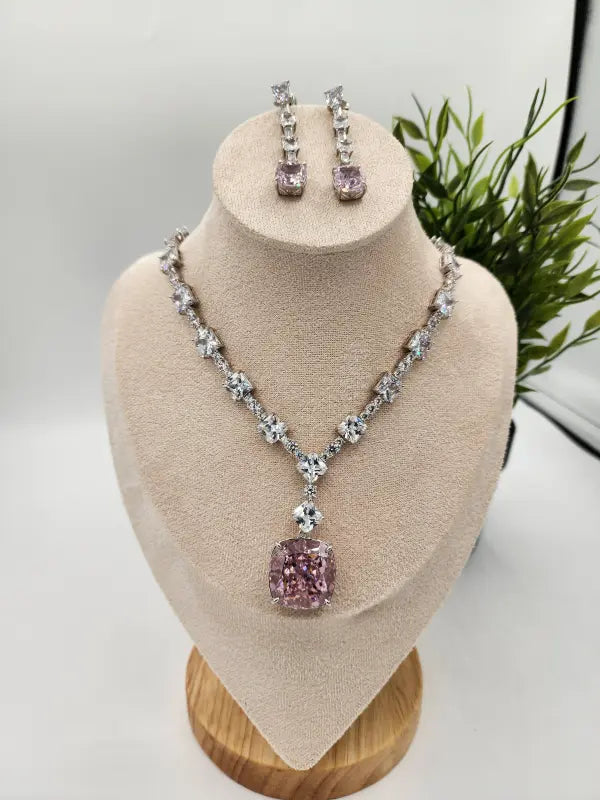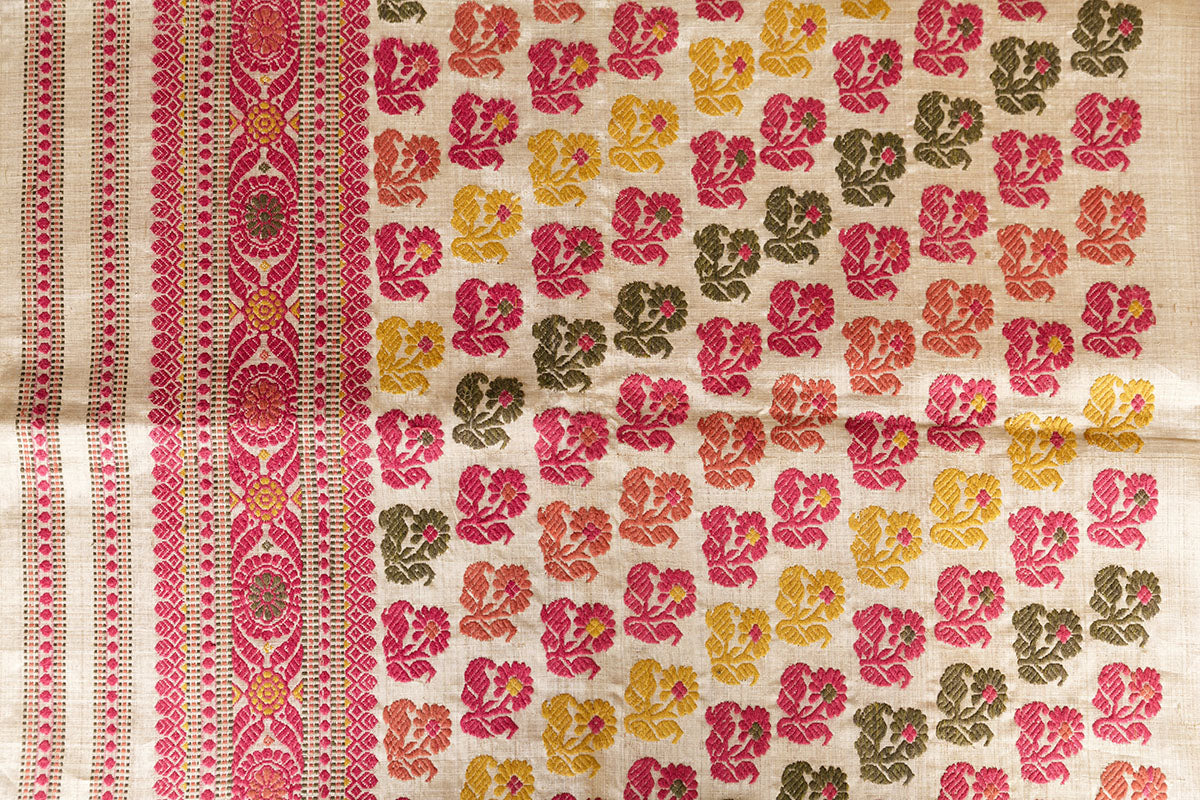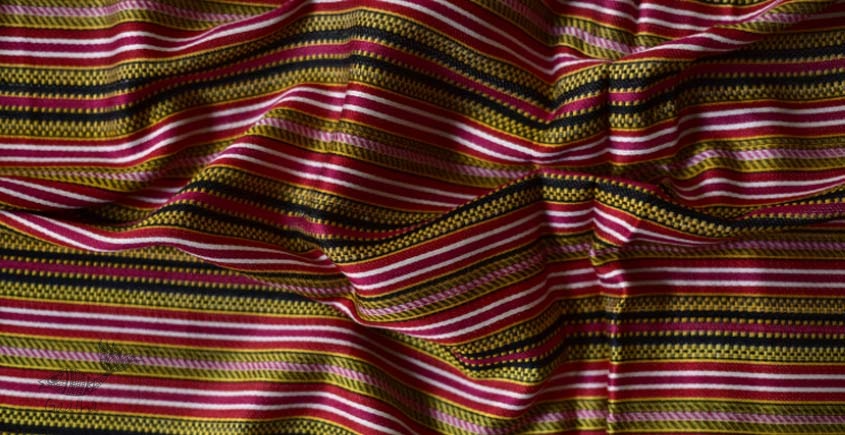The Mekhela Chador, or Mekhela Sador, is a distinctive and traditional garment from Assam, a northeastern state in India. This traditional attire is cherished for its elegance and cultural significance, making it a central element in Assamese women's wardrobes. Let's explore the various aspects of the Mekhela Chador, from its traditional draping style to the materials used in its creation.
Draping and Design

The Mekhela Chador is a two-piece outfit that is skillfully draped around the body, creating a graceful and traditional appearance. The attire consists of two main pieces:
- Mekhela: This is the bottom portion of the outfit, draped from the waist downwards. The Mekhela is a wide cylindrical piece of cloth that is folded into pleats and tucked into place around the waist. The pleats are typically folded to the right, differing from the saree, where pleats are folded to the left and generally in greater numbers. Unlike the saree, strings are not used to secure the Mekhela; instead, an underskirt with a string is often used to hold it in place.
- Chador: The top portion of the Mekhela Chador is called the Chador. It is a long piece of cloth that is draped over the chest and back. One end of the Chador is tucked into the upper part of the Mekhela, while the rest is draped around the body. The other end of the Chador is tucked into the belly after forming a few pleats. Traditionally, a fitted blouse is worn with the Mekhela Chador. In the past, a garment called the Riha was worn either as a chador or an inner piece beneath it. The Riha is still part of the Assamese bridal trousseau and is worn during traditional events like Bihu and other festivals.
Traditional Patterns and Motifs

The Mekhela Chador is renowned for its intricate designs and patterns. Unlike printed fabrics, the ornamental designs on Mekhela Chadors are traditionally woven. The weaving process is a meticulous craft that reflects Assamese culture and artistry. Some of the common patterns include:
- Phul (Flowers): The bright and vibrant floral patterns are a signature feature of the Mekhela Chador. These designs are often delicately woven into the fabric.
- Diamond Motifs: The diamond motifs, showcasing fine workmanship, are a traditional and typical feature of Assam's textiles. These designs are often prominent in Pat and Muga silk.
- Geometric Shapes: In Eri and Cotton fabrics, bold geometric motifs are commonly used, adding a contemporary touch to the traditional attire.
- Animal and Bird Motifs: Traditional motifs may include representations of animals and birds, adding to the cultural richness of the garment.
Materials Used

The choice of material in the Mekhela Chador is integral to its elegance and comfort. Traditionally, Mekhela Chadors are made from the following materials:
- Cotton: Known for its breathability and comfort, cotton Mekhela Chadors are popular for everyday wear and informal occasions.
- Muga Silk: Muga silk, exclusive to Assam, is a prized material known for its durability and natural golden hue. It adds a touch of luxury to the Mekhela Chador.
- Pat Silk: Pat silk is another traditional fabric used in Mekhela Chadors. It is known for its smooth texture and sheen, making it suitable for special occasions.
- Eri Silk: Eri silk is appreciated for its soft texture and eco-friendliness. It is commonly used in Mekhela Chadors for its unique appearance and comfort.
Modern variations of the Mekhela Chador may blend traditional fabrics with synthetic materials to offer more affordable options. These blends often combine cotton with Muga or Pat silk, providing a mix of comfort and elegance.
Conclusion
The Mekhela Chador is more than just traditional attire; it is a representation of Assamese culture and craftsmanship. The garment’s intricate designs, traditional patterns, and diverse materials make it a symbol of elegance and heritage. Whether worn during festivals, weddings, or cultural events, the Mekhela Chador remains a timeless and cherished part of Assamese identity.
FREQUENTLY ASKED QUESTIONS
What is a Mekhela Chador?
- The Mekhela Chador is a traditional Assamese outfit consisting of two main pieces: the Mekhela (bottom portion) and the Chador (top portion). It is draped around the body and is known for its elegance and cultural significance.
How is the Mekhela Chador draped?
- The Mekhela is draped from the waist downwards with pleats tucked in, while the Chador is draped over the chest and back. The Chador's end is tucked into the Mekhela, creating a graceful look.
What materials are used to make a Mekhela Chador?
- Traditional materials include Cotton, Muga Silk, Pat Silk, and Eri Silk. Modern variations may blend these with synthetic fabrics for affordability.
What are some common patterns on Mekhela Chadors?
- Common patterns include floral designs (Phul), diamond motifs, geometric shapes, and representations of animals and birds. These designs are traditionally woven into the fabric.
Is the Mekhela Chador worn for special occasions only?
- While the Mekhela Chador is often worn during festivals, weddings, and cultural events, it can also be worn for everyday occasions, depending on the material and design.




